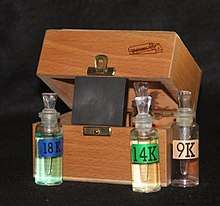Touchstone (assaying tool)
A touchstone is a small tablet of dark stone such as slate or lydite, used for assaying precious metal alloys. It has a finely grained surface on which soft metals leave a visible trace.[1]

History
The touchstone was used during the Harappah period of the Indus Valley Civilization ca. 2600–1900 BC for testing the purity of soft metals.[2] It was also used in Ancient Greece.[3]
Operation
Drawing a line with gold on a touchstone will leave a visible trace. Because different alloys of gold have different colours (see gold) the unknown sample can be compared to samples of known purity. This method has been used since ancient times. In modern times, additional tests can be done. The trace will react in different ways to specific concentrations of nitric acid or aqua regia, thereby identifying the quality of the gold. Thus, 24 carat gold is not affected but 14 carat gold will show chemical activity.
See also
- Litmus test (chemistry)
- Spot analysis
References
- "Touchstone". Oxford English Dictionary. Retrieved 10 March 2013.
- Venable, Shannon L. (2011). Gold : A Cultural Encyclopedia. Santa Barbara, CA: ABC-CLIO, LLC. p. 264. ISBN 978-0313-384318.
- Bisht, R. S. (1982). "Excavations at Banawali: 1974–77". In Possehl, Gregory L. (ed.). Harappan Civilization: A Contemporary Perspective. New Delhi: Oxford and IBH Publishing Co. pp. 113–124.